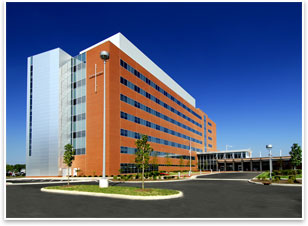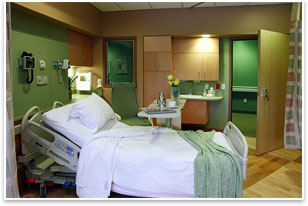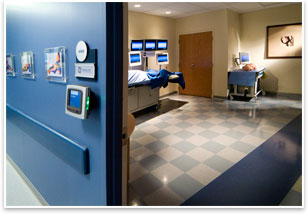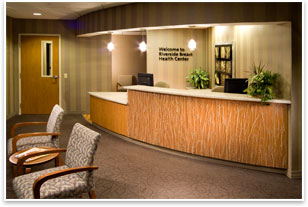The Prognosis of the Architecture Business in Health Care
by Curt Moody, FAIA, and J. William Miller, AIA
 Summary: The National Coalition of Health Care recently reported that in 2008 American health-care spending represented 17 percent of the gross domestic product (GDP), and by 2017, Americans will spend $4.3 trillion—or 20 percent of GDP—on health care. Demonstrating a continually increasing demand for patient care and treatment, these numbers are also a testament to why the architecture business in the health-care sector continues to maintain a relatively steady and positive outlook. After all, quality health care and facilities are—and always will be—a necessity. Summary: The National Coalition of Health Care recently reported that in 2008 American health-care spending represented 17 percent of the gross domestic product (GDP), and by 2017, Americans will spend $4.3 trillion—or 20 percent of GDP—on health care. Demonstrating a continually increasing demand for patient care and treatment, these numbers are also a testament to why the architecture business in the health-care sector continues to maintain a relatively steady and positive outlook. After all, quality health care and facilities are—and always will be—a necessity.
 Resilient, but not immune Resilient, but not immune
Although architecture projects in the health-care market have stayed buoyant compared to projects in other industries, they have felt declines. Large projects have been delayed or taken off the table due to uncertainty about where funds might come from to see them through to completion. In an effort to fully revitalize the industry, $150 billion from the Obama Administration’s stimulus package has been allocated to the health-care sector, which could subsequently help boost demand for architecture and design. Although we don’t yet know precisely how much of these funds will be directed toward construction efforts in the industry, a February 23, 2009, article in Modern Healthcare reported the distribution breakdown:
- $87 billion to Medicaid
- $25 billion to extending COBRA Insurance initiatives
- $19 billion for information technology advancements
- $19 billion purposed for all other areas, including medical research and construction projects.
Conservative institutions with funded depreciation accounts could take advantage of this depressed construction market
Although the amount of stimulus money going to health-care construction projects remains uncertain at this time, many health-care providers are funding smaller projects out of existing operations budgets to avoid the capital funding markets. In the short term, these smaller projects are offering the most opportunity for architects. Additionally, some conservative institutions with funded depreciation accounts could be in a good position to take advantage of the potential savings in a depressed construction market. As the banking situation stabilizes, large projects will likely resurface, perhaps as early as the third or fourth quarter of this year.
 Seeking a second opinion Seeking a second opinion
Aside from depending on capital funding for projects, health-care organizations can seek assistance from other programs as well. At the recent AIA 2009 National Convention and Design Exposition, for example, we discussed the increasing need for sustainable design, a practice that can be directly applied to projects within the health-care sector—the buildings that we use to get healthy in and also those that promote a healthy environment. Additional programs and grants are available for projects that are energy efficient and slated for LEED™ certification. Outside of health care, these subsidies can be sought for projects in all sectors, and this trend is likely to see significant growth due to the current administration’s commitment to environmental responsibility.
 Additionally, the concept and strategy of design-build teams are sought in increasing frequency, which was noted in an April 15, 2009 article in The New York Times. Budget assessments show a need for belt tightening, and organizations are seeking more efficient ways to achieve desired end results. Consequently, some institutions and government bodies are revising their contracting policies to allow the adoption of the design-build project delivery method. The U.S. Department of Veterans’ Affairs is using this approach extensively in its medical facilities, having adopted a two-stage process–first creating a “bridging package” to set parameters for function, cost, schedule, and quality and then releasing it to reputable design-build vendors for bids. Additionally, the concept and strategy of design-build teams are sought in increasing frequency, which was noted in an April 15, 2009 article in The New York Times. Budget assessments show a need for belt tightening, and organizations are seeking more efficient ways to achieve desired end results. Consequently, some institutions and government bodies are revising their contracting policies to allow the adoption of the design-build project delivery method. The U.S. Department of Veterans’ Affairs is using this approach extensively in its medical facilities, having adopted a two-stage process–first creating a “bridging package” to set parameters for function, cost, schedule, and quality and then releasing it to reputable design-build vendors for bids.
Ultimately, to survive—and thrive—in today’s economic environment, clients in all industries are maximizing their dollars and exploring new solutions to building challenges. In turn, it is increasingly important for firms to diversify their offerings and provide competitive services—from responsive architecture and sustainable design consultation to design-build capabilities.
|


 Summary:
Summary: Resilient, but not immune
Resilient, but not immune Seeking a second opinion
Seeking a second opinion Additionally, the concept and strategy of design-build teams are sought in increasing frequency, which was noted in an April 15, 2009 article in
Additionally, the concept and strategy of design-build teams are sought in increasing frequency, which was noted in an April 15, 2009 article in